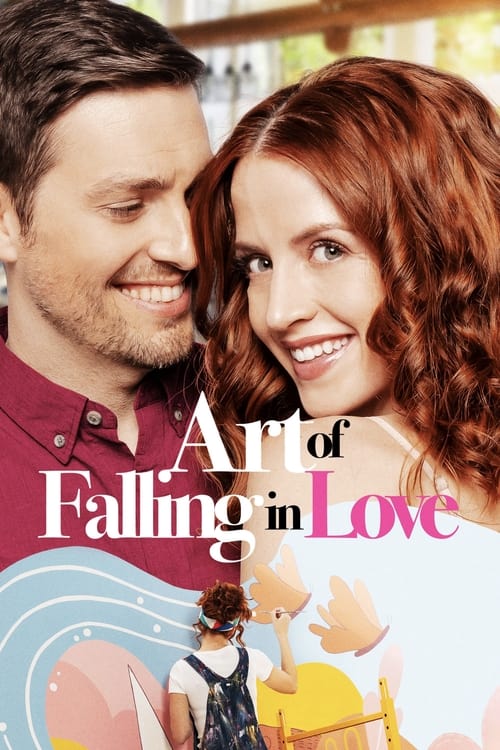
Ask Your Own Question
What is the plot?
Vanessa Harper arrives in a quaint town with the steady rhythm of a woman who carries both a restless spirit and a guarded heart. She's a traveling mural artist, commissioned to paint a vibrant mural on the new children's wing of the local hospital. The film opens with her setting up her paints and brushes at the hospital construction site, her curly red hair catching the soft morning light as she surveys the blank wall that will soon burst with color and life. Vanessa's presence is magnetic yet elusive; she moves with the confidence of someone who has learned to live fully but also with the caution of someone who has been deeply hurt.
At the hospital site, Nate Collins, the architect overseeing the project, is reviewing blueprints and construction progress. Nate is a man shaped by recent pain--a divorce that left him wary of new attachments. His demeanor is practical, grounded, and somewhat skeptical about the mural's place in his architectural vision. When Vanessa overhears Nate questioning whether her mural fits the sterile, modern aesthetic he's designed, she confronts him with fiery conviction: "This mural isn't for you, Nate. It's for the kids who will spend time here. It's hope on a wall." The tension crackles between them, but beneath it lies a mutual respect that neither wants to admit yet.
Vanessa retreats to her temporary apartment nearby, a modest space where she reflects on the past she rarely speaks of. She experiences dizzy spells and takes prescription pills, subtle signs of a fragile health condition she keeps hidden. Through flashbacks, the audience learns that Vanessa is a cancer survivor. During her treatment, she formed a close bond with another patient, a dear friend who ultimately succumbs to the illness. This friend left Vanessa a trust fund and a handwritten bucket list--a collection of dreams and experiences meant to push Vanessa to live boldly, despite the shadow of loss.
Back at the hospital, Vanessa's mural begins to take shape, vibrant and full of life, a stark contrast to the sterile walls around it. Nate watches her work, his initial skepticism softening as he sees the joy and hope her art brings to the space. Their interactions grow warmer, shifting from professional friction to tentative friendship. Nate shares glimpses of his own pain--a recent divorce that left him cautious about love. Vanessa, however, remains guarded. When Nate casually calls her list a "bucket list," she freezes, her smile fading. "It's not just a list," she says quietly, "It's a promise. And a reminder." This moment marks the first of many times Vanessa pushes Nate away, afraid to reveal the depth of her vulnerability.
In the community surrounding the hospital, Vanessa and Nate begin to find moments of connection. They share laughter, small adventures, and conversations that hint at something deeper. Vanessa's bucket list includes daring activities--tango lessons, rock climbing, scuba diving--that she approaches with a mix of excitement and fear. Nate encourages her gently, wanting to be part of her journey but unsure if she's ready to let him in fully.
The emotional tension builds as Vanessa's health issues become more apparent. Her dizzy spells grow more frequent, and she hides her medication from Nate, afraid he will see her as fragile or broken. One afternoon, Nate confronts her gently: "Vanessa, you don't have to carry this alone. Let me in." She pulls away, the walls she's built around her heart closing tighter.
A pivotal confrontation occurs when Vanessa's past catches up with her. During a community event, Nate accidentally stumbles upon her bucket list and the trust fund letter from her deceased friend. Feeling hurt that she kept such an important part of her life secret, Nate asks, "Why didn't you tell me about any of this?" Vanessa's defenses crumble as she reveals the story of her friend's death, the cancer battle, and the promise to live fully despite the pain. "I'm scared, Nate," she admits, tears glistening, "Scared that if I let you in, you'll leave like everyone else."
The climax unfolds on a crisp autumn evening at the hospital. The mural is nearly complete, a kaleidoscope of colors symbolizing hope, resilience, and new beginnings. Vanessa and Nate stand before it, the weight of their fears and hopes hanging between them. Vanessa takes a deep breath and says, "I want to trust you. But it's hard." Nate steps closer, taking her hands in his. "I'm not going anywhere. We can face this together."
The film's resolution is tender and hopeful. Vanessa's health remains uncertain, but she no longer hides from the possibility of love and connection. The mural is unveiled in a heartfelt ceremony attended by the community, children, and hospital staff. Vanessa and Nate stand side by side, their smiles genuine and their futures intertwined. The final scenes linger on the mural's vibrant colors, a testament to healing and the courage to embrace life's uncertainties.
No one else dies in the story; Vanessa's friend's death remains a poignant memory that shapes Vanessa's journey. The confrontations between Vanessa and Nate, though emotionally charged, lead to growth rather than division. Vanessa's secret--the bucket list and the trust fund--becomes a bridge rather than a barrier.
In the end, Art of Falling in Love closes on the message that love and healing are possible, even after profound loss. Vanessa, once a woman running from connection, now stands rooted in a community and a relationship built on trust, hope, and the art of falling in love.
More Movies Like This
Browse All Movies →What is the ending?
In the ending of "Art of Falling in Love," the main characters, who have navigated their feelings and misunderstandings throughout the film, come to a resolution. They confront their emotions and ultimately choose to be together, embracing the love they have developed.
As the film draws to a close, we find ourselves in a picturesque park setting, where the sun is setting, casting a warm golden hue over everything. The air is filled with a sense of anticipation and hope. The protagonist, a young woman named Emma, stands nervously, her heart racing as she waits for the man she has grown to love, Jake.
Scene 1: The Confrontation Emma recalls the moments of doubt and confusion that plagued her throughout the story. She remembers the misunderstandings that led to their separation, the times they almost confessed their feelings but hesitated. As she stands there, she feels a mix of anxiety and excitement, knowing that this moment could change everything.
Scene 2: Jake's Arrival Jake arrives, looking slightly disheveled but determined. His expression is a blend of relief and apprehension. He approaches Emma, and the tension in the air is palpable. They exchange glances filled with unspoken words, both aware of the weight of their past experiences.
Scene 3: The Heartfelt Conversation They begin to talk, their voices soft but earnest. Emma expresses her fears about love and vulnerability, revealing how she has struggled to open her heart. Jake listens intently, his eyes reflecting understanding and empathy. He shares his own journey, the mistakes he made, and how he has come to realize that love is worth the risk.
Scene 4: The Moment of Truth As they stand facing each other, the world around them fades away. Emma takes a deep breath, summoning her courage. She tells Jake that she wants to take a chance on their relationship, to embrace the love that has blossomed between them. Jake's face lights up with joy, and he admits that he feels the same way.
Scene 5: The Embrace In a moment filled with emotion, they step closer and embrace, their hearts finally aligned. The camera captures the warmth of their connection, the relief of finally being honest with each other. The background blurs, emphasizing the significance of this moment in their lives.
Scene 6: A New Beginning The film concludes with a montage of Emma and Jake together, exploring their relationship. They are seen laughing, sharing intimate moments, and supporting each other in their individual pursuits. The final shot shows them walking hand in hand, symbolizing their commitment to face the future together, no longer afraid of love.
In the end, Emma and Jake find happiness in each other, having learned that love requires vulnerability and trust. Their journey reflects the importance of communication and the courage to embrace one's feelings, ultimately leading to a fulfilling relationship.
Is there a post-credit scene?
In the movie "Art of Falling in Love," there is no post-credit scene. The film concludes with a satisfying resolution to the main characters' journey, focusing on their growth and the evolution of their relationship. The story wraps up without any additional scenes after the credits, leaving the audience with a sense of closure regarding the characters' arcs and the themes of love and self-discovery explored throughout the film.
What challenges does the main character face in her career?
The main character, a talented but struggling artist named 'Lily', faces significant challenges in her career as she tries to establish herself in the competitive world of art. She grapples with self-doubt and the pressure to create work that resonates with both critics and the public. Her journey is marked by moments of frustration as she navigates the complexities of artistic expression while trying to stay true to her vision.
How does the relationship between Lily and the male lead develop throughout the film?
Lily's relationship with the male lead, 'Jake', evolves from initial animosity to a deep emotional connection. They start off as rivals, each vying for the same art grant, which creates tension and misunderstandings. As they are forced to collaborate on a project, they begin to see each other's vulnerabilities and strengths, leading to a blossoming romance that is both tender and fraught with the challenges of their artistic ambitions.
What role does the art competition play in the story?
The art competition serves as a pivotal plot device that drives the narrative forward. It not only sets the stakes for Lily and Jake's professional aspirations but also acts as a catalyst for their personal growth. The competition forces them to confront their fears, insecurities, and ultimately, their feelings for each other, as they both strive to create a piece that reflects their true selves.
How does Lily's family influence her decisions throughout the film?
Lily's family plays a significant role in shaping her decisions and emotional state. Her parents, who have traditional views on success, pressure her to pursue a more stable career rather than her passion for art. This familial expectation creates internal conflict for Lily, as she struggles to balance her desire for approval with her need to follow her artistic dreams. Their interactions highlight her journey of self-discovery and the importance of pursuing one's passion.
What is the significance of the final art piece created by Lily and Jake?
The final art piece created by Lily and Jake symbolizes their growth as individuals and as a couple. It reflects their collaborative journey, merging their distinct styles and perspectives into a cohesive work of art. This piece not only represents their artistic achievements but also encapsulates the emotional journey they have undergone together, showcasing themes of love, vulnerability, and the beauty of collaboration.
Is this family friendly?
"Art of Falling in Love," produced in 2019, is generally considered family-friendly, but there are a few elements that might be sensitive for children or more sensitive viewers.
-
Romantic Tension: The film explores themes of love and relationships, which may include moments of romantic tension that could be awkward for younger viewers.
-
Emotional Conflict: Characters experience emotional struggles, including heartbreak and misunderstandings, which may evoke feelings of sadness or discomfort.
-
Mild Language: There may be instances of mild language or expressions that some parents might find inappropriate for younger audiences.
-
Personal Challenges: Characters face personal challenges and insecurities that could resonate with viewers who have experienced similar feelings, potentially leading to emotional reactions.
Overall, while the film is light-hearted and focuses on romance, these elements could be considered for viewers who are particularly sensitive to emotional or relational themes.




























